
NASA’s Scientific Visualization Studio (SVS) has released a stunning video that shows Earth in a way you may have never seen before.
The video is a timelapse simulation that depicts seven days in 2005 when a category-4 typhoon developed off the coast of China. The seven-day period is repeated several times during the course of the visualization.
Scientists used data from NASA’s Goddard Earth Observing System Model, Version 5 (GEOS-5), to depict the simulation’s volume-rendered clouds. This particular run of the simulation, called 7km GEOS-5 Nature Run (7km-G5NR), was executed on a supercomputer. This short visualization produced petabytes of output and referenced nearly a terabyte of brickmap files.

According to the SVS website, the goal of videos like the above is to provide the public with a clearer picture of our planet and our own place within it, as well as give people an idea of what NASA is all about: “The SVS works closely with scientists in the creation of visualizations, animations, and images in order to promote a greater understanding of Earth and space science research activities at Goddard Space Flight Center and within the NASA research community.”
Based on this video, I’d say that they seem to have gotten things right.